101 Norway

Red with a blue cross outlined in white that extends to the edges of the flag. The vertical part of the cross is shifted to the hoist side in the style of the Dannebrog (Danish flag). The colors recall Norway’s past political unions with Denmark (red and white) and Sweden (blue).
Flag courtesy of the CIA World Factbook
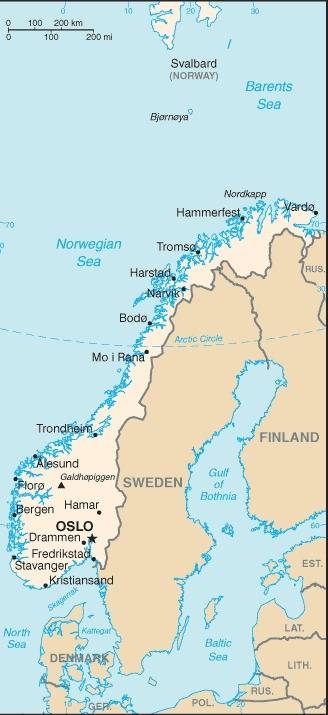
Map courtesy of the CIA World Factbook
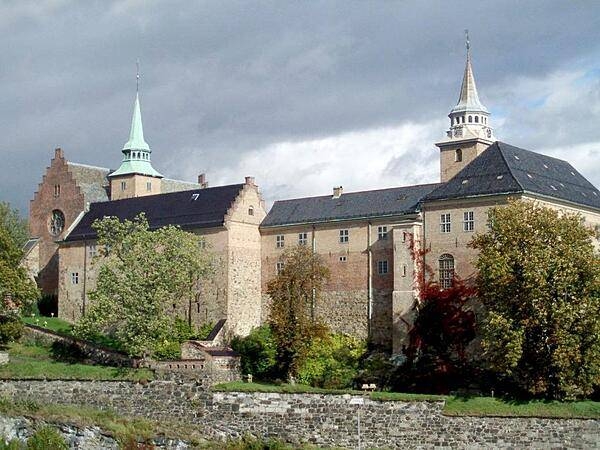
Akershus Fortress is a medieval castle built to protect the city of Oslo; construction dates back to the late 1290s. Today the grounds house several museums and are popular visitor destination.
Photo courtesy of the CIA World Factbook
Government
According to Britannica, Norway is a constitutional hereditary monarchy. The government, comprising the prime minister and the Statsråd (Council of State), is nominally chosen by the monarch with the approval of the Storting (Stortinget), the country’s legislature. Until 2009 the Storting operated as a bicameral body, though most matters were addressed in unicameral plenary sessions. Only when voting on laws was the Storting divided into two houses. One-fourth of the members were chosen to constitute the Lagting, or upper house, while the remaining members constituted the Odelsting, or lower house. Bills had to be passed by both houses in succession. In 2009 the Lagting was dissolved, and the Storting became permanently unicameral.
The constitution of Norway, drafted in 1814 when Norway left the 434-year union with Denmark, was influenced by British political traditions, the Constitution of the United States, and French Revolutionary ideas. Amendments can be made by a two-thirds majority in the Storting. Unlike many parliamentary forms of legislature, the Storting cannot be dissolved during its four-year term of office (amendments to overturn this restriction have been defeated frequently since 1990). If a majority of the Storting votes against an action advocated by the Statsråd, the minister responsible or the whole Statsråd resigns. In legislative matters the monarch has a suspending right of veto, but, since the 91-year union with Sweden was dissolved in 1905, this veto has never been exercised.
The Sami Act of 1987 sought to enable the Sami people “to safeguard and develop their language, culture, and way of life” and created the Sameting, the Sami Parliament, the business of which, according to the constitution, is “any matter that in the view of the parliament particularly affects the Sami people.”
The Finnmark Act, adopted by the Storting in 2005, transferred some 95 percent of the fylke (county) of Finnmark from state ownership to its residents through the establishment of the Finnmark Estate. The act recognized in particular that the Sami people, through protracted traditional use of the area, had acquired individual and collective ownership of the area and the right to use its land and water.
The city of Oslo constitutes one of the country’s 19 fylker (counties). The other counties are divided into rural and urban municipalities, with councils elected every fourth year (two years after the Storting elections). For the country as a whole, the municipal elections tend to mirror the party division of the Storting. The municipal councils elect a board of aldermen and a mayor. Many municipalities also employ councillors for such governmental affairs as finance, schools, social affairs, and housing. Norwegians pay direct taxes to both federal and municipal governments.
The counties can levy taxes on the municipalities for purposes such as roads, secondary schools, and other joint projects. The county councils comprise delegates from the municipalities, while the county governors are appointed by the Statsråd.
Before civil cases ordinarily can be taken to court, they first must be submitted to the local conciliation boards (forliksråd), which settle many issues without recourse to more formal legal action. Decisions of the conciliation boards can be appealed to the courts, and Norway also has a formal system of courts of appeal. The Supreme Court is the final arbiter of legal decisions. The rights of the citizens also are guarded by ombudsmen, who act on their behalf as an intermediary in matters with public administrators.
Civil / National Aviation Authority (CAA/NAA)
The Civil Aviation Authority (CAA) of Norway’s main objective is to contribute to safe civil aviation in Norway.
Airspace
SkyVector – Google Maps – ADS-B Exchange
ICAO countries publish an Aeronautical Information Publication (AIP). This document is divided into three parts: General (GEN), En Route (ENR) and Aerodromes (AD). ENR 1.4 details the types of airspace classes they chose to adopt from classes A through G. AVINOR AIP
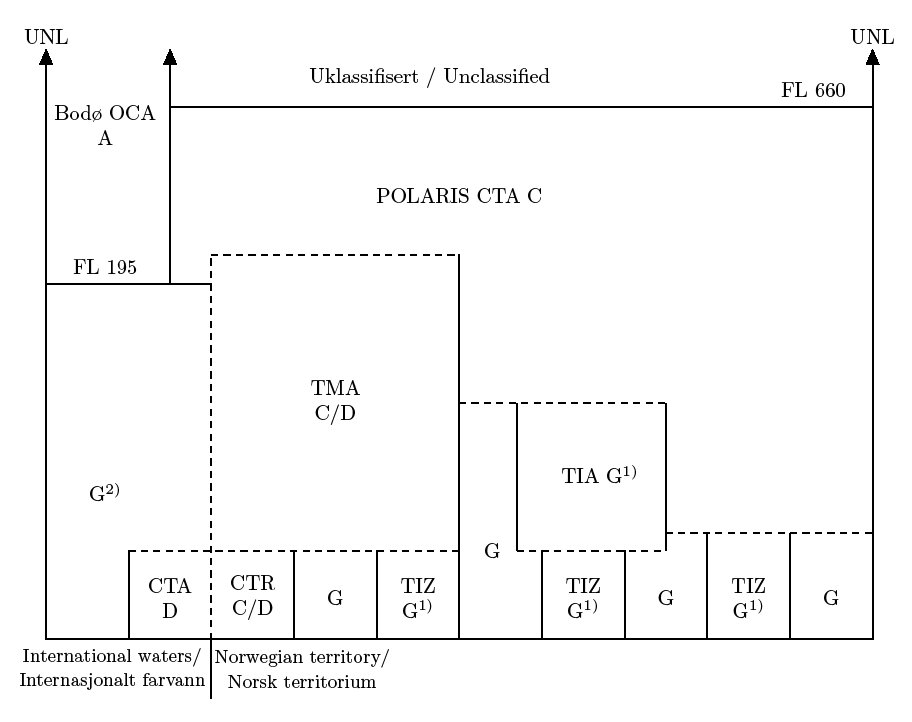
Drone Regulations
You can register, take online courses and exam at flydrone.no. Telephone hours to reach the section for unmanned aviation are Tuesdays and Thursdays between 10:00 and 14:00.
Guide for flying drones in Norway
In Norway, you are generally allowed to fly in the open category if you are registered as an operator. This does not apply to Russian citizens, as there is a ban on all Russian flights.
Citizens from EU countries
If you are a citizen of an EU country and wish to operate a drone in Norway, you must:
- Be registered as a drone operator in your home country. There is no distinction between flying for recreational or commercial use.
- Have a valid EASA certificate for the relevant subcategory.
(The Norwegian A1/A3 course and exam are available in English at flydrone.no.) - Mark the drone with your operator number.You can also use a QR code containing your operator number. The number on your pilot certificate is not valid as a marking.
- Have valid liability insurance. There is no distinction between flying for recreational or commercial use.
- Follow the rules of the open category.
- Check if drone flying is permitted in the area before taking off.
- Before flying with sensors, you must register the use of photos, video and other sensors with the Norwegian National Security Authority.
Russian citizens
Since 28 February 2022, Russian flights have been banned from using Norwegian airspace.
- Read more about the ban in the article: Russian citizens are not allowed to fly in Norway, Svalbard or Jan-Mayen.
- It is permitted that Russian citizens, as employees (or similar), can fly a UAS to benefit operators not subject to the sanctions.
Citizens from other countries
If you are a citizen from a country outside the EU, you must:
- Be registered as a drone operator in an EU country or Norway. You should register in the first country where you plan to operate. For Norway, you can register at flydrone.no. There is no distinction between flying for recreational or commercial use.
- Have a valid EASA certificate for the relevant subcategory.
(The Norwegian A1/A3 course and exam are available in English at flydrone.no.) - Mark the drone with your operator number. You can also use a QR code containing your operator number. The number on your pilot certificate is not valid as a marking.
- Have valid liability insurance. There is no distinction between flying for recreational or commercial use.
- Follow the rules of the open category.
- Check if drone flying is permitted in the area before taking off.
- Before flying with sensors, you must register the use of photos, video and other sensors with the Norwegian National Security Authority.
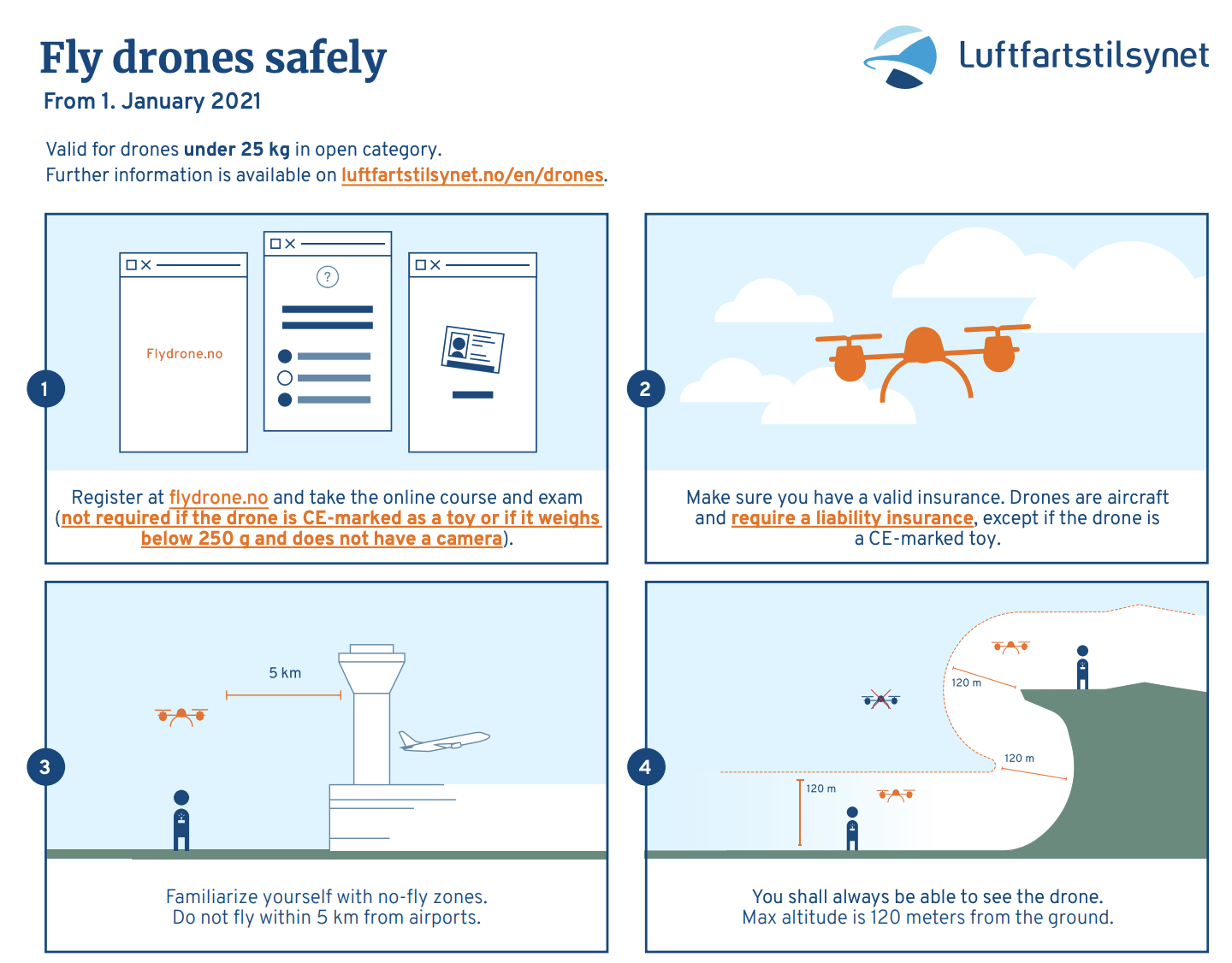
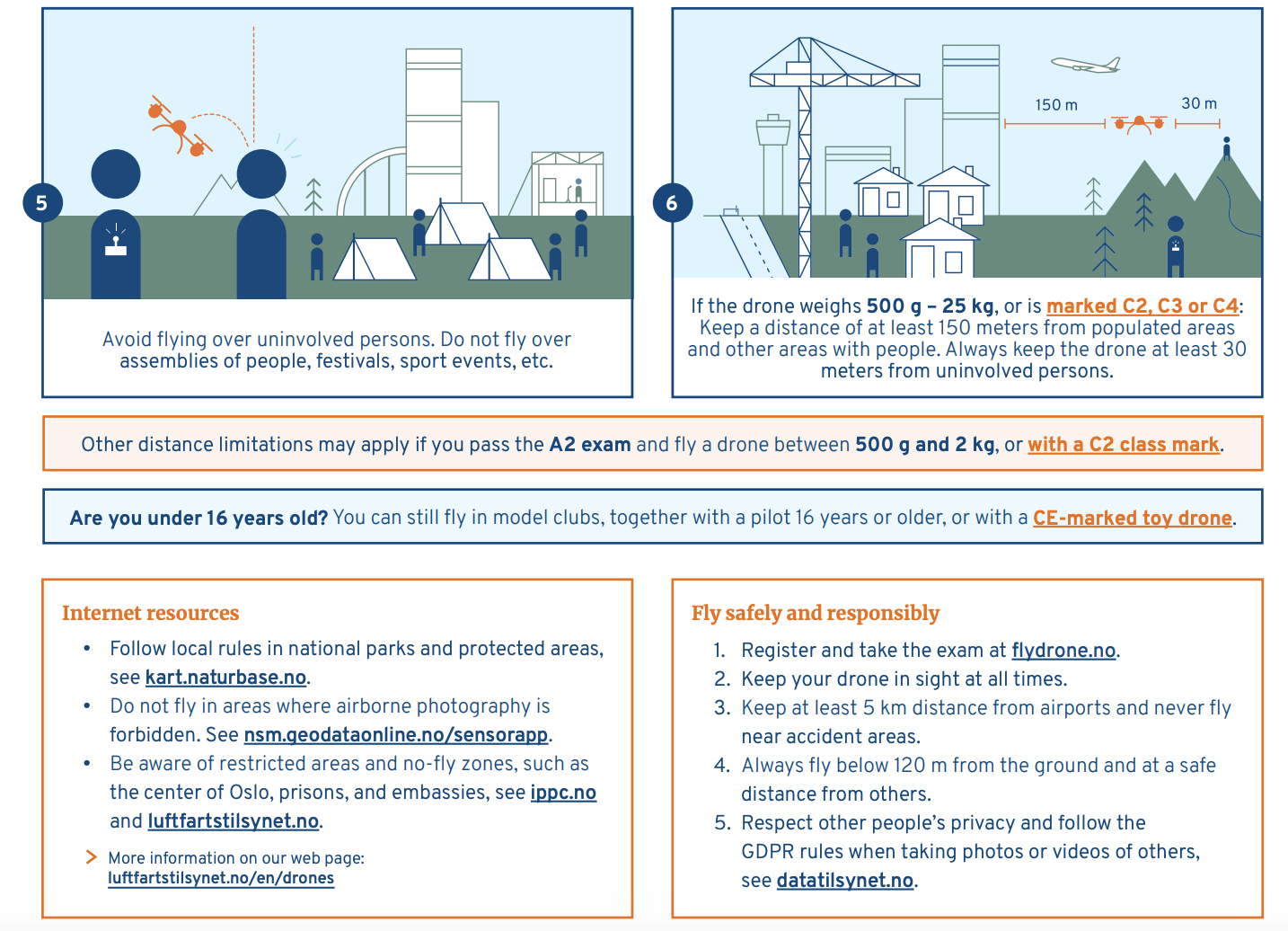
No-drone zones
Before taking off you need to make sure it is allowed to fly there. You also need permission from the land owner of the area where you will take off and land.
List of areas with restrictions
- Within 5 km from airports. Go to Ninox Drone and Avinor for more info.
- Nearby ongoing emergency operations
- Restricted airspace.
- Permanent areas are displayed on ICAO Norway charts. This can also be downloaded in some mobile apps for air navigation.
- Temporary areas will be published by NOTAM. See IPPC.no
- Some nature conservation areas.
- Areas with sensor restrictions
- Prisons
- Embassies
- Military areas and vessels
Airports
It is not permitted to fly closer than 5 km from an airport without permission from the air traffic service, ie. the tower at the airport. Airports may have different procedures for how to apply for a permit. Most use an app called Ninox Drone.
More information can be found on the airport’s website or you can contact the airport. Many airports in Norway are operated by Avinor and they have gathered information on their websites.
In the near future, the 5 km rule will change. It will probably be forbidden to fly within an airport control zone, CTR, without a permit. Maps of the control zone can be found in AIP, and maps for Avinor’s airports on their websites. At several of Avinor’s airports, you will be able to request and obtain a permit, through an app. It is likely that this will apply to most airports within some time. Some airports already have the app in use, where the restriction applies within 5 km. The solution is called Ninox Drone.
Restricted airspace
Restriction and danger areas are airspace areas created to protect flights or set special conditions for flight. This can often mean a flight ban for drones, for example in the restricted area R102 which covers Oslo city center. Here you must have permission from CAA Norway to be able to fly. This area is created to protect the inhabitants, and central government functions, from aviation incidents.
An example of temporary restricted areas where it is not permitted to fly without a permit are priority areas where an accident has occurred. Danger areas can be permanent or activated by Notice to Airmen (NOTAM). Danger areas are often created to protect others from what is going on there, for example, military firing ranges are typically covered by danger areas. You will find information on both restricted and danger areas in AIP and on NOTAM.
NOTAM can be checked at IPPC.no
The app Ninox Drone also show some restriction areas.
Photo and sensor restricted areas
Some areas have restrictions regarding the use of airborne sensors. It is the Norwegian National Security Authority (NSM) that controls sensor use from the air. NSM has published a separate map showing these areas.
Nature and environmental considerations
Nature conservation areas, such as national parks, may have their own rules for drone flying. It is described in the regulations of the individual area, and you can often find information on the national parks own website. To find out if you are in a protected area, you can check maps published by the Norwegian Environment Agency. Many of these areas are also marked with small signs in the terrain.
Military areas, prisons and embassies
It is not allowed to fly over or near military areas/vessels, prisons and embassies. Often these are marked, but be aware that a temporary military training area can also be defined as a military area.
C-UAS
Countering the Drone Threat: Implications of C-Uas Technology for Norway in an EU and NATO Context
Advanced Air Mobility (AAM)
Short Essay Questions
Question 1
You have been hired by a Drone Startup Company. Your boss has immediately assigned this job to you.
They need you to prepare a one-page memo detailing the legalities of using a drone to film in Oslo, pictured above.
They need you to mention any national laws and local ordinances.
They specifically want to know what airspace you will be operating in and whether or not you need an airspace authorization.
Does it matter whether or not you are a citizen of the country?
Lastly, there is a bonus for you if, as you scroll through this chapter, you find any typos or broken links!
Question 2
Do you need a certificate to fly UAS?
If so, how do you obtain one?
Are there fees associated with this?
If so, how much?
Question 3
May you operate beyond visual line of sight?
If so, what procedures must you follow?
Question 4
Does the country have UAM/AAM laws? If so, describe, citing the exact law.
Question 5
Are you aware of any new laws or policies not mentioned above? If so, describe, citing the exact law or policy.

